The main thing during the repair is the wall decoration in the kitchen. It is necessary to choose finishing materials that are practical and beautiful, but this is not easy: not everyone meets the requirements.
Requirements for finishing materials for the kitchen
The kitchen belongs to rooms with difficult conditions: there is often high humidity, evaporation, splashes of grease. Therefore, the materials for finishing the walls of the kitchen should be well washed, should not react to high humidity.
In addition to cooking, in most families the kitchen is also used as a dining room. And if so, then the finish should also be beautiful. Naturally, it should be safe for health and, preferably, durable.
Satisfies all conditions not so many materials. Rescues only a wide variety of textures and colors, but appeared in recent times novelties. So, wall decoration in the kitchen is carried out using:
- ceramic tiles and mosaics;
- washable wallpaper;
- waterproof paint;
- panels from MDF, plastic;
- decorative plaster.
Due to the fact that different functions are combined in one room, even a small kitchen is divided into two zones - working and dining. And emphasizes the separation of the use of different finishing materials, including for walls. So most often you have to choose two types of wall decoration for the kitchen - something very practical, easy to clean in the work area, and in the dining area in the same style and color, but more comfortable.
Ceramic tiles and mosaics
Wall tiles for kitchen walls are an excellent option in terms of durability and ease of maintenance. But if the whole room is tiled, it will be uncomfortable in it, like in an operating room. Another disadvantage is the high cost of the material itself and its installation: it is not very simple, therefore, craftsmen are more often hired, and their work is not cheap.
Therefore, in modern repairs, for the most part, ceramics trim the working area - the space of the wall between the floor and hanging cabinets. This piece is also called. Previously, it was made only from tiles, today this material has worthy competitors - glass-ceramic and plastic panels, MDF panels, decorative and natural stone.
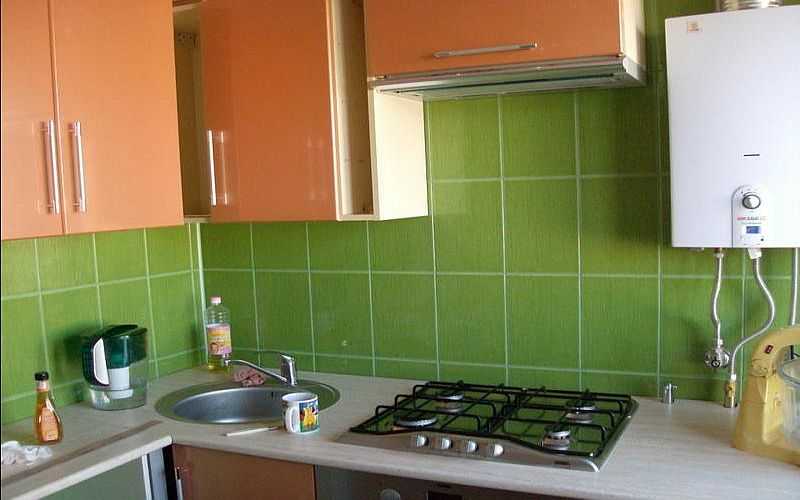
All new materials are easy to install - they are mounted on several bolts, they do not require a perfectly flat wall surface. It is even easier to care for them, since there are very few seams - at the junction of panels - and they can be sealed with sealant to prevent moisture and dirt from entering. In general, ceramic tiles are a good option for finishing the working area in the kitchen, but not the only and not the best.
Ceramic tile options
But, despite the availability of new materials, tile is still the most popular option for finishing a work wall in the kitchen. Only in the style of design there were significant differences. The 15*15 cm or 18*18 cm square tiles, which were widely used earlier, are no longer popular. Large formats are in favor - long rectangular or square, but with a side of at least 35 cm, or even 50-70 cm. So it turns out that one or two rows of tiles are required for a kitchen apron.
Collections are curly, with patterns, drawings, there are - smooth Long and narrow tiles are called "boar" Large fragments - one at the height of the apron
Which specific tile to choose - smooth, with texture, with or without drawings - it's up to you. Textured, of course, looks very interesting. But in practicality, it is inferior to a smooth surface: dirt and soot clog into the recesses. It takes a lot of effort to bring it back to normal.
Mosaic wall decoration
Mosaic wall decoration in the kitchen looks good. This is a very small ceramic, glass-ceramic or glass tile glued to the grid - for faster installation. Small squares can be of the same color, or they can be of different shades in the same scale, there is a mosaic lined with patterns and even paintings. This type of finishing material is even more expensive than ceramic tiles, but it also has a non-standard look.
Mosaic panel - a non-standard solution Patterns in different styles- beautiful and original Different colors and sizes of tiles - rare collections, but very beautiful Mirror mosaic on the walls of the kitchen - an option for high-tech style Green with brown and gray - a cozy and calm combination Gray - the best background for brighter elements
You can decorate with mosaics in the kitchen not only the working wall. The same panel is made over the dining table. It harmonizes the interior. In addition, another frequently soiled area receives an easy-to-clean coating.
Wallpapers: washable and paintable
This type of finishing materials is mostly used on the walls in the dining area of the kitchen. In the work area, even super-washable and super-durable wallpaper will not last long. Especially around the sink.
According to the technology, wall decoration in the kitchen with wallpaper means first, wallpaper is glued onto a flat surface. The best choice is vinyl coated. Vinyl forms a dense film that can be wiped with a cloth. There are technologies that allow you to get such a durable coating that these wallpapers can be washed with a brush using liquid (non-abrasive) detergents.
Vinyl wallpaper is based on paper, there is on non-woven. Non-woven on a flat surface are glued very easily. If the walls in the kitchen were not level, it is better to take paper-based vinyl wallpaper, and choose thick paper and textured roll surface. This will help hide imperfections.
Wall murals on the wall in the kitchen - a popular type of design
A separate category is to highlight the wallpaper for painting. They should also stick to flat surfaces. They are often made on the basis of fiberglass. They are painted with water-based paint, without problems you can repaint from 3 to 20 times (depending on the type of wallpaper, the more you can repaint, the more expensive the wallpaper). We will talk about the choice of paint in the next section.
Another separate type of wallpaper is photo wallpaper. Bright or pastoral landscapes, city shots, kitchen "still life" - whatever your heart desires. It is usually glued to the wall near which there is a table or to a free wall. By the way, there is a way to blur the boundaries in a rectangular kitchen - to stick a large-format image with a call to the next wall. The visual perception of the room immediately changes.
wall painting
The choice of wall paint for the kitchen is not so great - water-based paints are most suitable, but you need to take them washable. This type of paint can be repainted without problems, but it is easier to wash. That's why we choose those.
According to the technology, finishing the walls in the kitchen with paint - on a flat, pre-primed wall. The type of primer is selected depending on the type of paint (with acrylates, alkyd and silicate). After the primer dries, paint is applied in several layers. Since the base is water, there is practically no smell, after drying, a film of varying degrees of strength is formed (read more about paints for finishing).
Pastel shades for a "light" interior The traditional method of combined coloring - one wall is bright, the rest are neutral On the painted walls, you can apply a pattern Light furniture - bright walls. Common decorating technique
Finishing the walls of the kitchen with the help of painting can be background, dim, or, on the contrary, attract attention. Background paints are chosen if they are bright colors, and walls are made bright if the facades are neutral.
Decorative plaster
I also call decorative plaster “liquid wallpaper”. These compositions are textured and smooth. Smooth - Venetian plaster based on marble dust with various additives. To the touch, the surface is silky, has a muted sheen very similar to silk. Textured plasters are of two types. In the first, the relief is obtained due to the presence of some large inclusions in the composition (usually quartz sand of different grain sizes), in the second, the relief is obtained due to application with special rollers, brushes, spatulas.
Finishing the walls in the kitchen with smooth decorative plaster occurs after careful alignment of the walls. The composition is very expensive and it is extremely unprofitable to spend it on leveling defects. In addition, the slightest irregularities spoil general impression. Structural decorative plasters can be used to finish imperfect walls - the surface will still be uneven, so perfect smoothness is not required. What is mandatory in any case is a preliminary primer for better adhesion to the surface.
Decorative plaster for walls in the kitchen a good choice- it is washable, retains its appearance for a long time, many pigments do not fade or fade. The disadvantage is the high price of the material and the complex application technique, which not all “masters” can handle. In addition to the ability to plaster, artistic taste is required here, and not everyone has it.
Natural and decorative stone
Non-standard wall decoration in the kitchen is done using natural or artificial decorative stone. Natural - sawn into thin plates of different sizes and shapes. Artificial - made on the basis of gypsum or cement, with the addition of crumbs of natural minerals. Natural stone is heavier and more expensive, it is more difficult to lay it. Artificial is lighter in weight, much cheaper, easier to install, one side of it is like a tile, the second imitates the surface of a stone and color and shape.
Imitation of the old brickwork- one of the latest trends Wall decoration in the kitchen with decorative stone - one of the options
- natural or artificial - requires some skill. You also need to level the surface first before starting finishing work. Lay on tile adhesive, first covering with a primer. After laying the stone, the seams are embroidered (with mortar or grout), after which the wall is varnished - to make it easier to care for.
Wall decoration in the kitchen with plastic panels
If you are looking for an inexpensive and quick way to finish your kitchen, consider plastic wall panels. They are mounted on the crate, fastened with screws or staples from a stapler. It is completely optional to level the walls - the crate will hide all the flaws. Wall decoration in the kitchen PVC panels, probably the most fast way update the room. Also the cheapest. There are a lot of color options - from plain matte or glossy to imitation tiles, wood and other surfaces and materials.
Wall decoration with plastic - urgent and inexpensive repairs
Naturally, there are disadvantages - unnatural raw materials and fragility. Raw materials are not natural, but under normal operating conditions (do not exceed the temperature) harmless. With fragility. nothing can be done - plastic panels have jumpers between two layers of polymer. On impact, they collapse. There are, however, subtle Wall panels PVC, but they are glued to even walls. Either way, if you're looking for a quick and inexpensive way to update your kitchen wall coverings, consider plastic paneling.
MDF panels
Another easy and quick way to make repairs is to decorate the walls in the kitchen with MDF panels. They are also mounted on the crate, but they are much more expensive than plastic ones. One way to trim an apron without tiles is to use MDF boards. In addition, the rest of the walls can be decorated with this material. It is made from waste wood crushed into flour, which is splashed at high pressure. The resulting boards are then laminated with foil. MDF can have a lot of colors, but the most popular ones are imitation of wood of different breeds and shades.
Two shades of brown - a cozy interior in modern style Imitation of the surface of a stone is also interesting
There are different color schemes for decorating walls in the kitchen with MDF panels:
- Choose the same color as on the countertop.
- Make an apron that matches the facade, and make the walls a different color.
- All walls and an apron in the kitchen are made in the same color, but it does not match the color of the furniture (contrasting or in the same range).
The disadvantage of this method of finishing kitchen walls is that MDF reacts to high humidity (a little, but expands). To reduce the effect, during installation, open sections are treated with a sealant.
The kitchen is the room where we spend most of our time preparing and eating, and that is why we need to devote Special attention. Moreover, the kitchen is also distinguished by rather specific conditions, because odors, steam, humidity are constantly present here, and the surface of the walls can be directly affected by splashes of grease and products. Based on all this, it becomes clear how important choose the right finishing material for the walls in the kitchen, which would meet all aesthetic and operational requirements. Today there is plenty to choose from, and we bring to your attention the most popular options.
No. 1. Ceramic tile
Just a couple of decades ago, most kitchens were completely finished, and there are a lot of reasons for that. Today, interior fashion has changed a little, and ceramic tiles are increasingly trimmed only in the working area. This material is, especially for that part of it, where all the cooking processes take place. The main advantages of ceramic tiles are:
- huge assortment, because the tile may differ in size, shape and type of surface. It can be glossy or embossed, matte or glossy, have any shade, pattern, ornament, imitate any material. In general, this is a real scope for imagination;
- moisture resistance. The material is not susceptible to moisture, does not absorb it, so it is ideal for the kitchen, and especially for the work area;
- low flammability;
- ease of care, because all the dirt and grease particles can be easily wiped off with just a damp cloth, and if necessary, detergents can also be used. For the kitchen, it makes sense to choose tiles with the designation AA - a symbol of the fact that the material endures the effects of aggressive substances;
- wear resistance and durability.
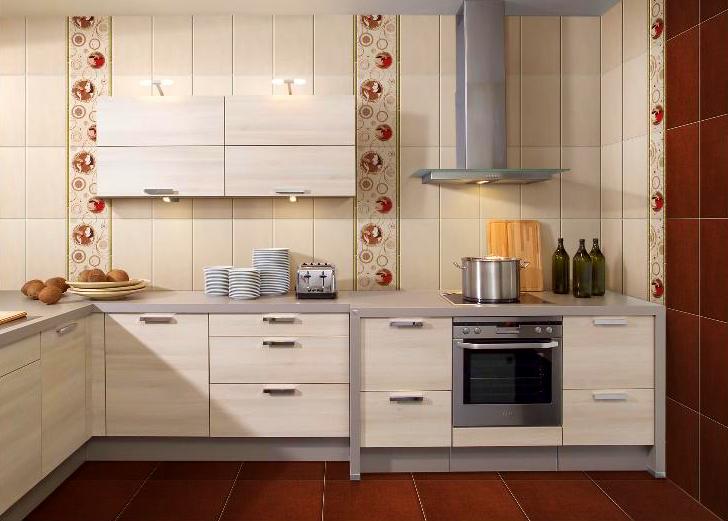
Some types of tiles are very decent, but when combining two finishing materials, when tiles are used only in the backsplash area, you can afford to purchase ceramic tiles with a guarantee of quality and reliability. It is also worth noting that it is not so easy, therefore may need specialist help. Some also opt for mosaic, which is similar to tiles in properties, but allows you to create slightly different decorative effects.
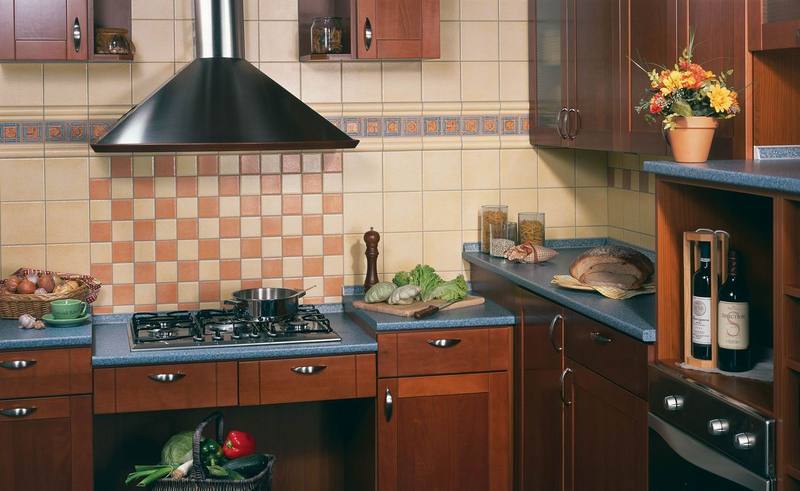
No. 2. Painting
In the kitchen - one of the most budget options but it's far from the worst. Since the paint can be completely different, even any shades, in the kitchen you can create exactly the interior that is needed. You can mix different shades, create drawings and patterns, but with all this it is important that the paint responds minimum requirements, retractable features of the kitchen room. So, the surface should be easy to wash, and therefore be moisture resistant. Among other advantages of paint it is worth noting ease of application- anyone can handle it, as well as excellent maintainability, as it is very easy to renew the coating with a new coat of paint.
To use this finish, it is important to properly prepare the surface of the walls: they must be even and free of defects, because cracks and depressions will be very noticeable under a layer of paint. By the way, a glossy finish often looks better, is easier to clean, but will emphasize all the bumps, so often the choice falls on matte paint.
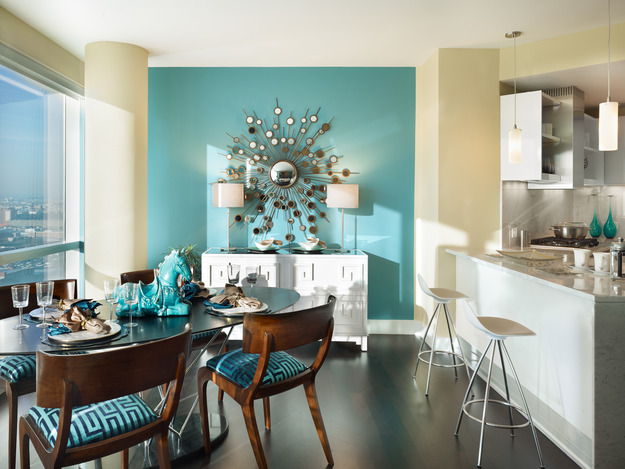
What paints will go for the walls in the kitchen?
- acrylic and latex. They are easy to apply, dry quickly, adhere well to the base, you can achieve any shade with the help of color, but before painting it is necessary to dry the walls well: several weeks must pass after them. acrylic paint differs even in greater wear resistance and moisture resistance than latex. The surface painted with such paint is easy to wash, it does not lose vapor permeability. Latex paints are often used to paint paintable wallpaper and show excellent durability and strength;
- alkyd paints today they are used infrequently, because when they are applied and dried, an unpleasant pungent odor is formed. Otherwise, they are great for kitchens: wear-resistant, moisture-resistant, perfectly tolerate temperature changes, direct sunlight, easy to apply, economical;
- silicone paints combine the advantages of previous types of paint. They have excellent performance properties, dry quickly and can be applied to freshly plastered walls. Their only drawback is their high price.
Even moisture-resistant paints are best used away from the work area to reduce the risk of grease and particles of different products on the surface. Combining different finishing materials in the kitchen is also a great way to highlight the cooking and eating areas.
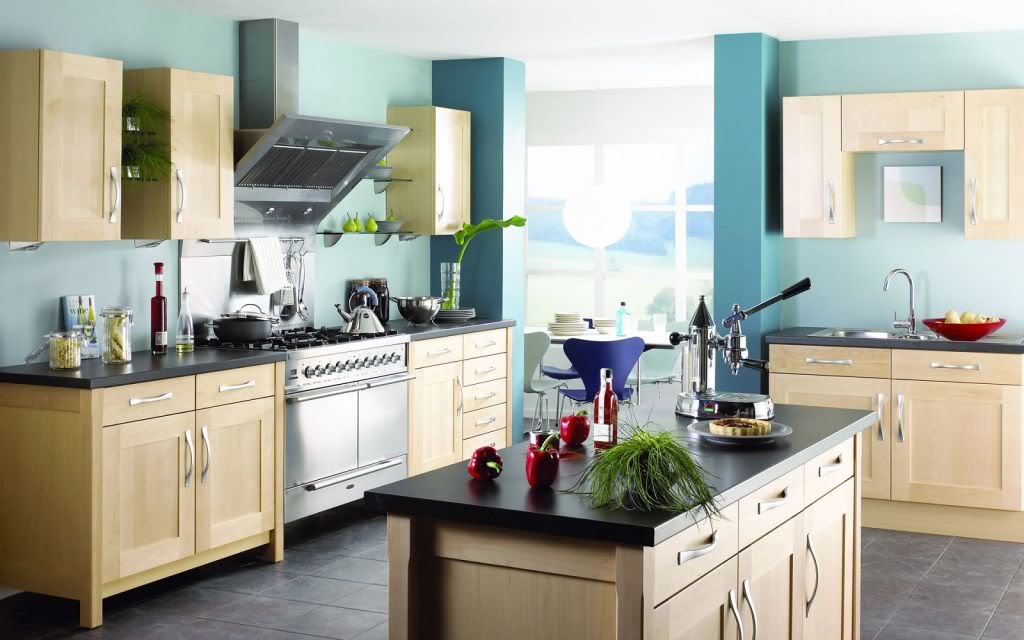
Number 3. Wallpaper
In the minds of many, they are associated with comfort, so why not move this comfort beyond? Yes, no doubt, in the kitchen and many other natural ones, but there are also such wallpapers,. To the pluses of wallpaper worth attributing economy, relative ease of installation, as well as the effects that can be achieved with their help, because range wallpaper today is simply amazing.
Ideal for the kitchen. They are not afraid of moisture, and in some cases even rubbed with a brush, they do not fade, do not absorb odors, are not afraid of grease and dirt, are durable and attractive in appearance. Their only disadvantage is the inability to breathe, which can adversely affect the microclimate. But there is a way out: it is better to ventilate or use the most modern type of finish - hard vinyl wallpaper.
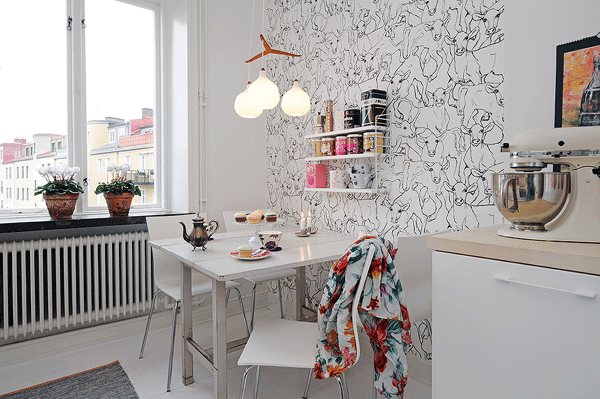
No major flaw vinyl wallpaper- they are well breathable. In terms of other properties, they are almost not inferior, being also moisture resistant and durable. Some types of such wallpaper can be painted several times.
You can also use for the kitchen, which demonstrate excellent indicators of reliability, durability, moisture resistance and fire resistance. They can be painted in any color, they reinforce the walls, hide imperfections. Glass fiber is not scary even to use in the working area of \u200b\u200bthe kitchen. They show well and the liquid wallpaper, which are distinguished by ease of application and the absence of seams. In the dining table area, you can use moisture resistant and even paper wallpaper with moisture-repellent impregnation, but the second option is not very durable.
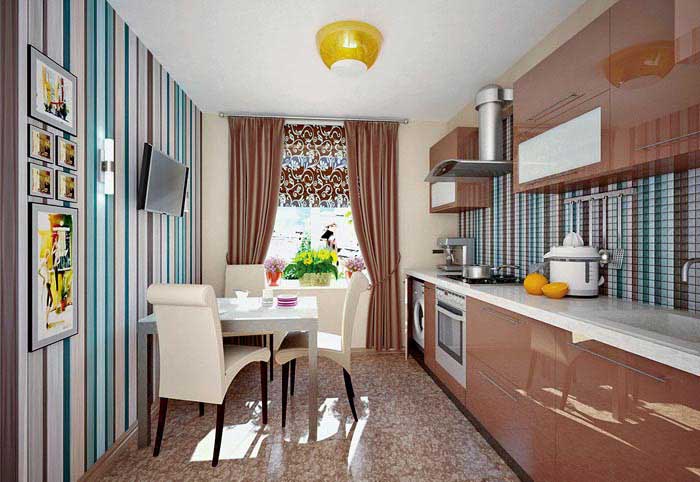
No. 4. Decorative plaster
An equally popular type of finish is. Today, the construction market offers a lot of different options with which you can create a unique and original coating. The advantage of decorative plaster is that from the same composition it always turns out unique drawing which you can create yourself. Most species just apply and do it yourself, but some will require the help of professionals, for example, when it comes to Venetian plaster.
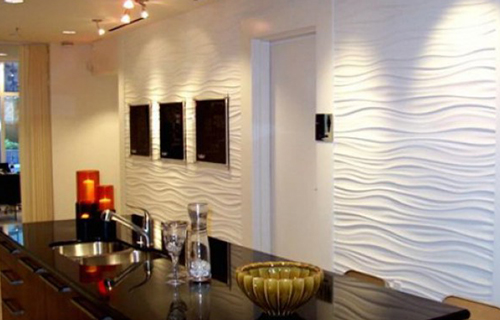
The advantages of decorative plaster should also include Can be applied to any type of material and seamless final surface. With this finish, you can mask some surface imperfections, while the walls themselves do not lose their ability to “breathe”. Many formulations include fungicides and antiseptics to prevent the appearance and development of mold, which often affects wet rooms, incl. and kitchen. The plaster is different wear resistance, it is not so easy to damage, it is durable, does not attract dust, which means it is easy to clean. The plastered surface can be washed, in which case it is easy to repair, it is not afraid of temperature changes, it is fire resistant.
Plaster as well as wallpaper, it is better not to use in the area of direct contact with water and dirt. If your plans are to perform some kind of unique design finish using plaster, then it will be difficult to cope on your own, and almost anyone can handle the most common process of applying plaster. It is also worth being prepared that cracks may appear on the plastered surface.
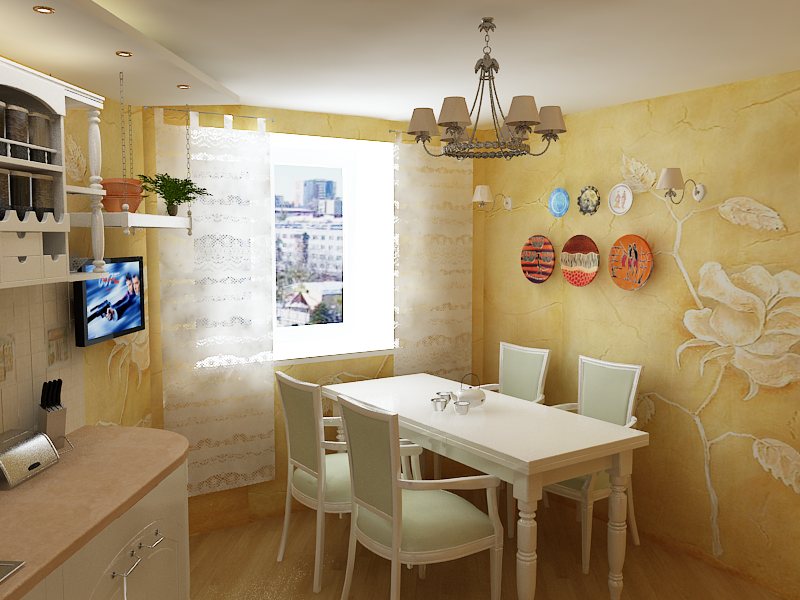
No. 5. Natural and decorative stone
The interior of the kitchen can be transformed beyond recognition. Natural stone has a lot of advantages: it is not afraid of water, does not burn, is hygienic and is almost always easy to clean. You can use marble, granite, slate, sandstone or any other type of stone that best meets the specific design idea. But natural stone is an expensive pleasure: the material itself and the installation work are quite expensive, and the material also weighs decently.
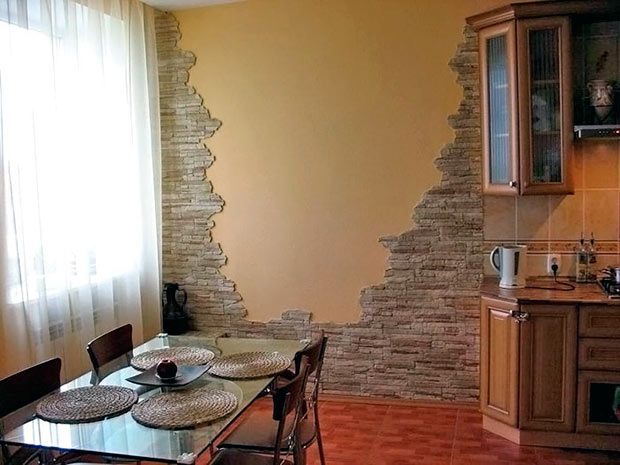
Great Alternative natural stone – artificial analogue. In appearance, it is very similar to natural, it is made from cement, sand, plasticizers and dyes, and it can be given any appearance, so it can imitate any kind of natural stone. Such material lightweight, easy to install and maintain, much cheaper than natural stone, perfectly tolerates moisture, does not burn, durable and strong, it can be washed and even rubbed. True, in terms of service life, he loses natural stone, but this disadvantage is fully compensated by its price, lightness and other useful performance properties.
The stone is so well tolerated by all the influences that are possible in the kitchen that it can be used to decorate the walls in the backsplash area, not to mention decorating the dining area. But you need to be careful with stone: when it is an ornament of a part of the room, the room looks stylish and unusual, but if all the walls are finished with stone, then there will be no trace of comfort and warmth. This is an option for those who want to style their kitchen under the castle.
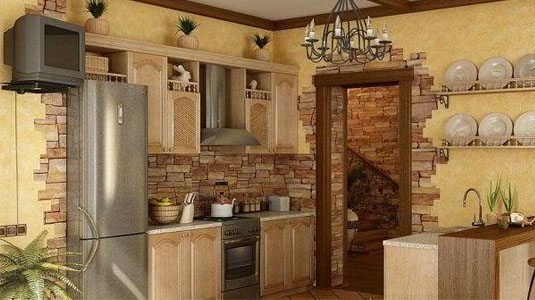
No. 6. Wooden lining
What could be better than natural wood in the decoration of the room, because it brings a special comfort and gives a unique aroma. An excellent option - which, while retaining all the positive qualities of wood, in the process of processing receives a number of other qualities that are useful in operation. As a result, this finishing material boasts chic appearance , naturalness, ability to withstand the effects of moisture, temperature changes, sunlight. The material is easy to wash, and many even risk using it to decorate the working area of the kitchen. But with all this, it should be borne in mind that the wooden lining "steals" usable area kitchen, and each wall will become closer to the center by 4-5 cm.
Excellent for kitchen conditions, pine, linden, alder, oak and teak lining are suitable. Naturally, this pleasure is not cheap, but a plastic lining can be called a more affordable analogue.
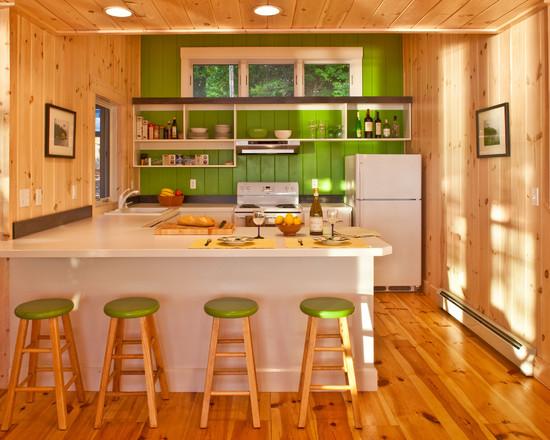
No. 7. Plastic panels
Plastic panels are an excellent material for decorating kitchen walls. Under this prefabricated name, they usually mean PVC lining with a width of up to 12.5 cm and a length of up to 3 m, wall panels with a width of up to 50 cm and PVC sheets with a width of 80 cm to 2 m and a length of up to 4 m. of these types of materials, their advantages in terms of ease of installation and appearance of the finished finish. In terms of performance, they all boast the same advantages:
- ease of installation and ease of construction;
- ease of care, because plastic can be washed using even detergents, except for abrasive ones;
- moisture resistance, therefore, the panels should not be afraid of contact with water, and fungus or mold will never start on them;
- panels tolerate temperature fluctuations, can withstand temperatures up to 120 0 С, but still it is better not to use them right next to an open fire;
- economy;
- huge range of possible colors, so you can create almost any kitchen interior.
However, plastic panels have some shortcomings, among which low strength, not very good wear resistance. In addition, with prolonged contact with direct sunlight, the previous color of the finish may be damaged. When buying such material, it is important to make sure that there are certificates confirming the safety of products.
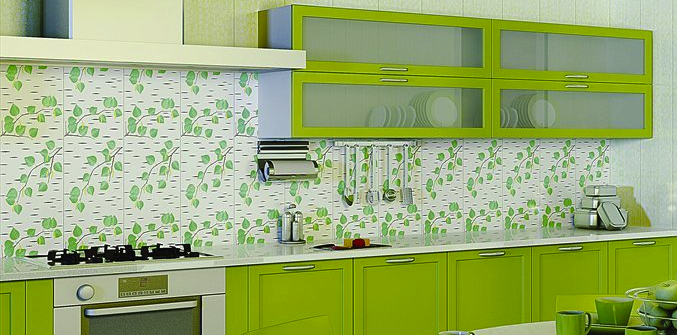
No. 8. glass panels
A rather unusual and rather rare way of decorating the walls in the kitchen. Glass panels can be used both in the work area and in the dining room, they have excellent performance and decorative qualities. Yes, on glass apply any drawing, even a photo, which means that the kitchen will receive an exclusive design. For the manufacture of panels, durable armored glass is used, which is difficult to break, but even if damaged, it cannot harm others. Such a finishing material is enough easy to install and maintain, not afraid of water, high temperatures, will not become a place for mold growth. Glass panels are durable, and the pattern on them will remain in its original form for a very long time. They are not afraid of strong heat, temperature changes, and it is very easy to wipe off all splashes and dirt from them. All this, together with a chic appearance, makes glass panels ideal for arranging a kitchen.
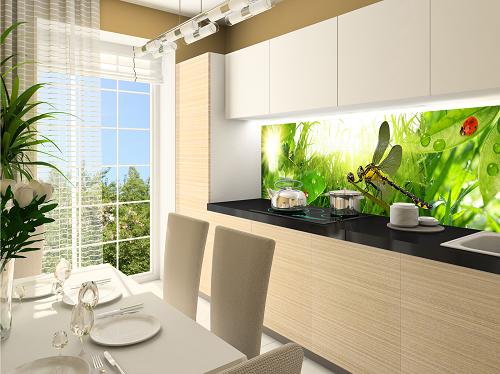
No. 9. Metal
At first glance, metal walls seem unacceptable, but for decoration kitchen apron they fit perfectly. This option is great for high-tech and minimalist kitchens. it very practical and durable finishing material which perfectly transfers influence of moisture, splashes, high temperatures. It is better to opt for stainless steel.
You can create metal walls in the kitchen by using various materials: this metal overlay on plywood or chipboard certain size, metal mosaic or tile with metal surface.
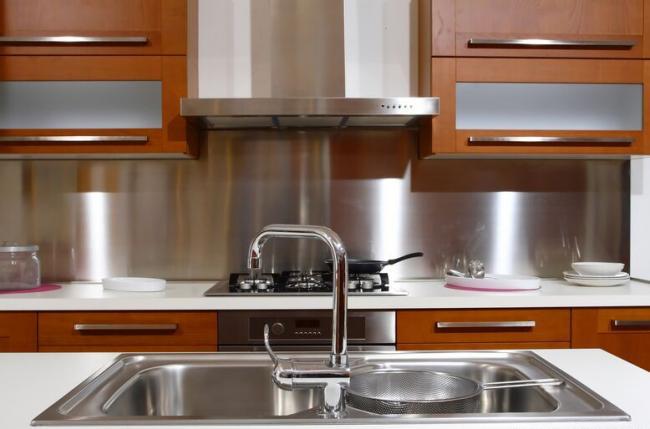
In conclusion
As you can see, there are a lot of different finishing materials for arranging the kitchen. Some of them can be called universal, others are suitable for a certain part of this room. By combining different materials, you can create a unique interior in the kitchen that will meet all aesthetic and operational requirements.
One of the central places in the apartment is the kitchen. It is used not only as a place for cooking, but also as a gathering point for the whole family. That is why it is so important to make the right design of this room, understand all the intricacies of its design and understand how to decorate the walls in the kitchen.
Wall finishing options
The kitchen differs from other rooms in the house in special conditions. Its walls experience high temperatures, smoke and soot, splashes of hot oil. Therefore, the decoration of the walls in such a room must be approached especially carefully. Their coverage must be high class protection from any kind of dirt and mechanical damage, but at the same time I would like to maintain a pleasant look for the eye of the room and decorative finishes.
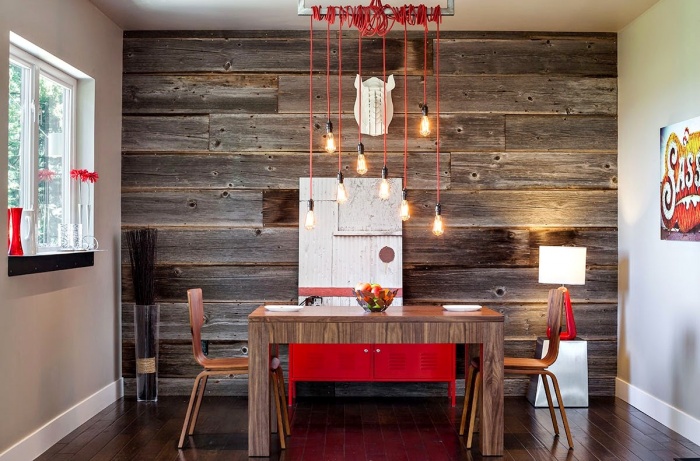
Finishing the kitchen is usually done with the following materials:
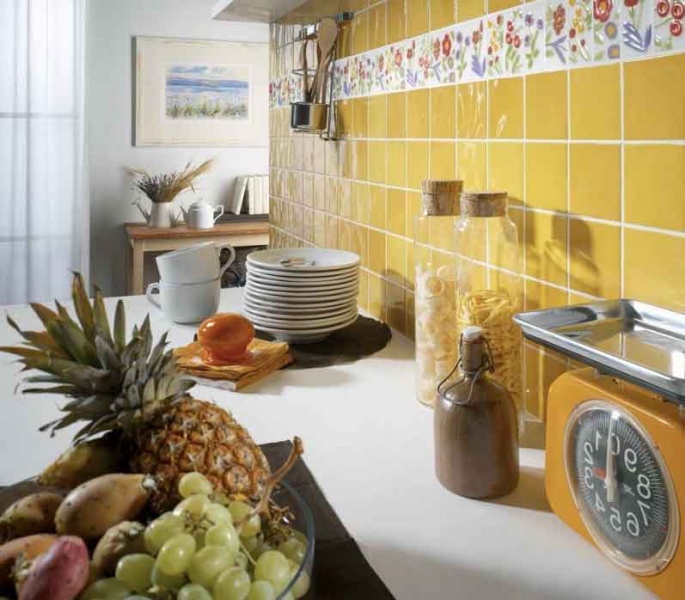
Quite wide in modern design kitchens, the use of artificial and natural decorative stone has spread. It is used to decorate the walls of a room and highlight various zones. Let's take a closer look at each of the described materials.
![]()
ceramic tiles
The modern market can provide quite a few different options for this tile. The options for covering it can be just as different:
- Smooth
- With gloss
- imitating texture
- Matte (as pictured)
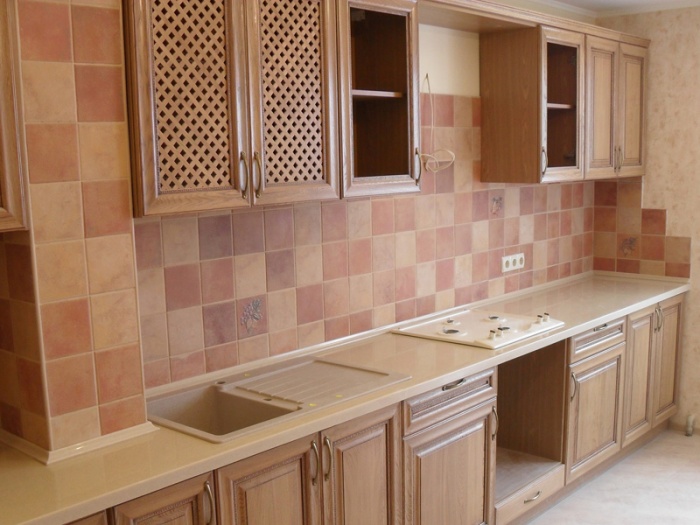
Choosing a tile for the kitchen, everyone can choose the option that is right for him.
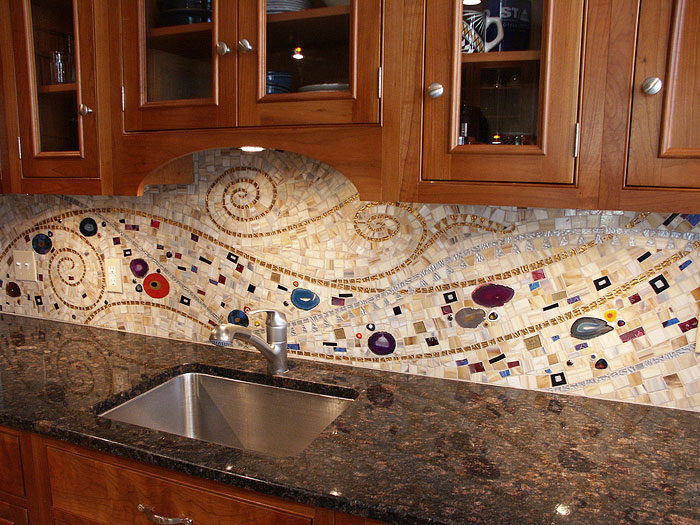
Previously, when it came to decorating kitchen walls, most often they turned to tile tiles, but now a lot has changed. Classic design rooms are no longer so popular, and tile tiles are most often used to create a kitchen apron. It looks good with plastered walls and painted wallpaper.
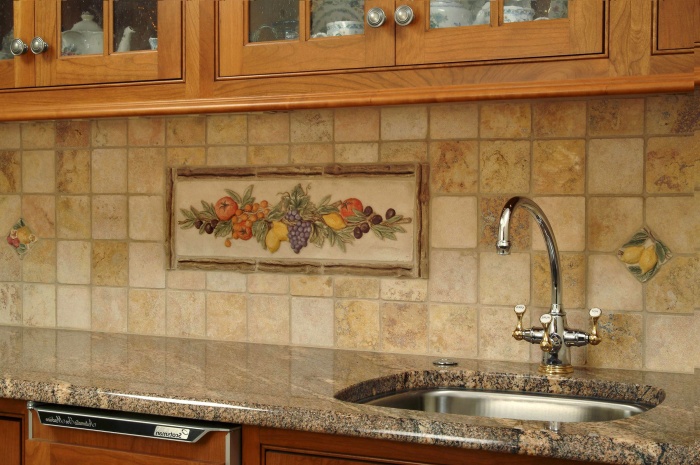
Interesting! To decorate a kitchen apron, you can use glass blanks from special panels. This design is devoid of seams, which get dust and other contaminants, and is also very easy to clean.
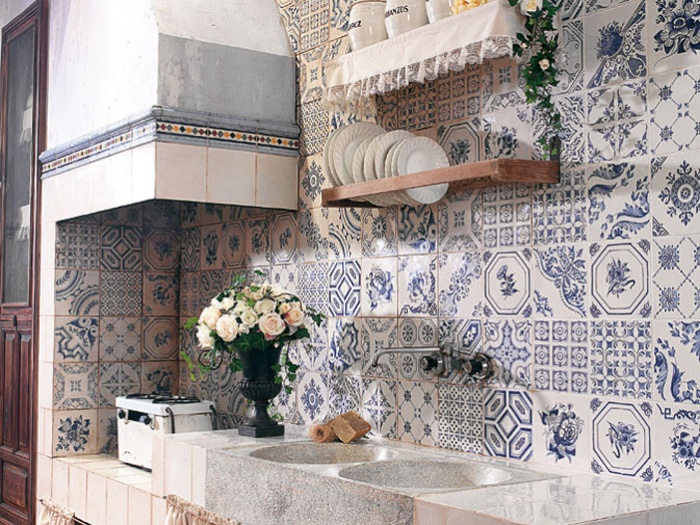
Use of paint
Specialized paint provides many options for decorating walls. This is the cheapest and most affordable finishing material for the kitchen, with which you can experiment and give free rein to your imagination. Different colors and textures of paint provide ample opportunities to create a unique style of the room.
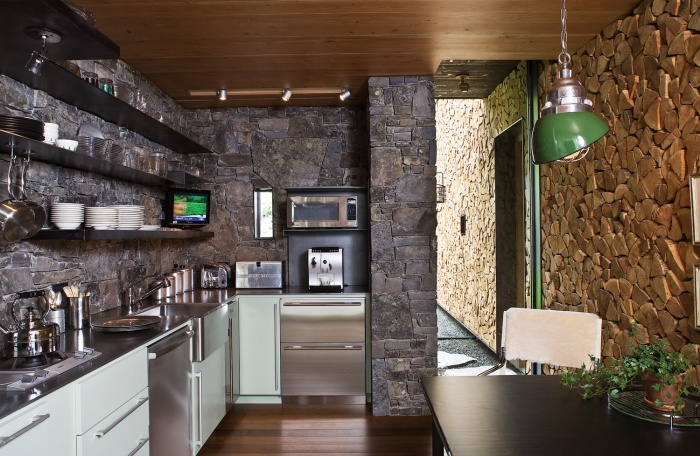
Moisture-resistant paint is considered the best option among finishing materials for the kitchen. Glossy varieties of this material are easily cleaned of dirt and retain their original appearance for a long time. At the same time, matte texture paint creates a wall surface identical to natural, but at the same time it is difficult to clean and easily absorbs dirt.
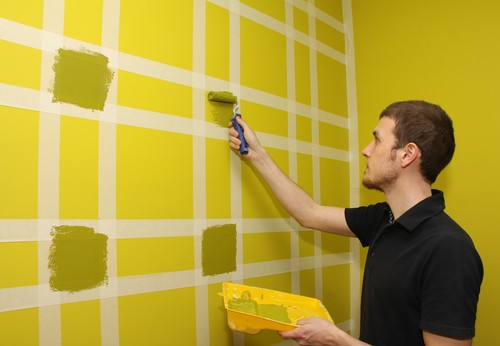
The main disadvantage of the paint is its ability to emphasize the bumps and defects of the walls.
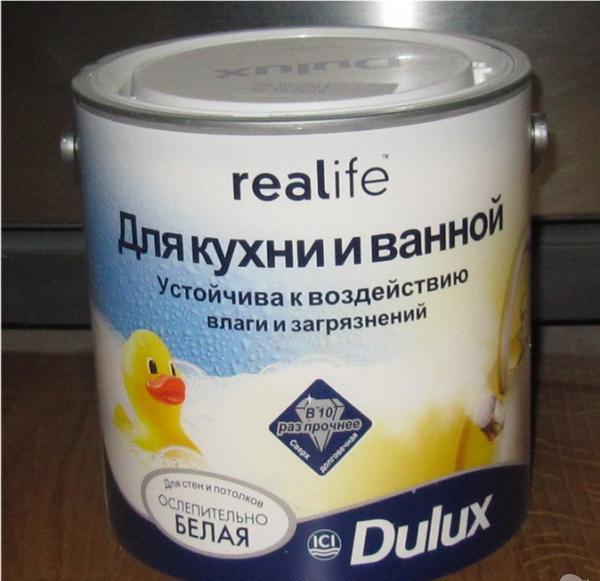
Wallpaper
Decorated wall decoration with wallpaper is the most cost-effective and common way. But when working with the kitchen, there are some subtleties here. Experts do not recommend using simple paper wallpapers for decoration, because they are very easy to get dirty, absorb unpleasant odors and have low moisture resistance.
One of the suitable materials for kitchen wallpaper for decoration can be called vinyl. These wall coverings are easy to clean with cleaning products, and they perfectly resist strong humidity. The surface of such wallpaper is protected by a specialized PVC film that can withstand dust accumulation, pollution, fumes, direct sunlight and high moisture content in the room.
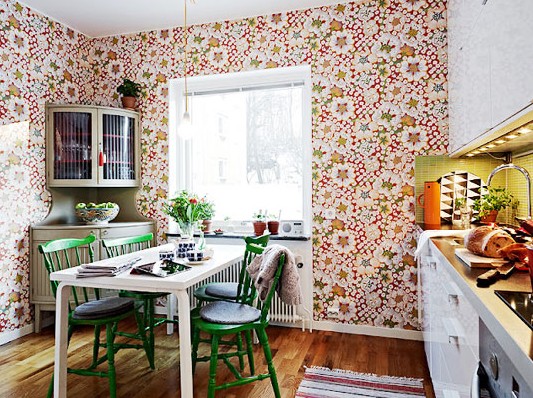
Also a great option would be to use non-woven wallpaper. Despite their relatively recent invention, they have already managed to establish themselves as a fairly durable and advantageously hiding the defects of the room, the coating. These wallpapers have the ability to pass air, which does not allow the fungus to spread under them.
Non-woven fabric does not swell due to high moisture content, retains its texture perfectly and does not peel off. In addition, paint easily adheres to it, which allows you to give the new kind interior decoration. Water-repellent and durable, this material is just perfect for walls in rooms like the kitchen. Perfectly cleanable and strengthening the walls, it will perfectly complement your unique style.
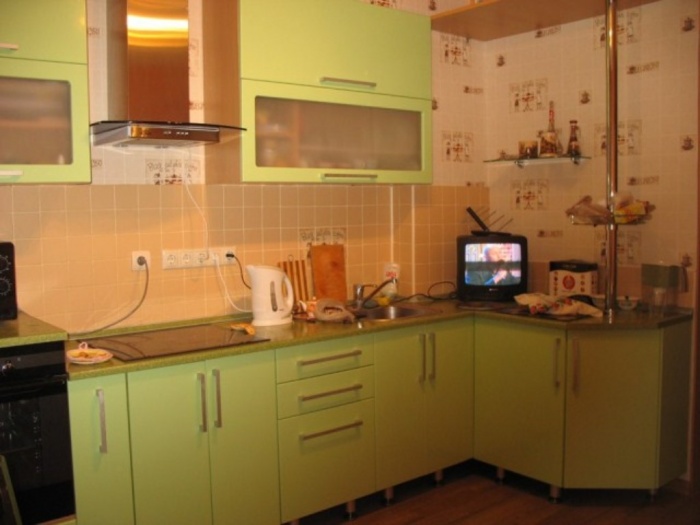
Plaster for decorative finishing
This type of finish is becoming quite popular now. decorative plaster. With this material, you can achieve a spectacular finish that creates a luxurious and unique design.
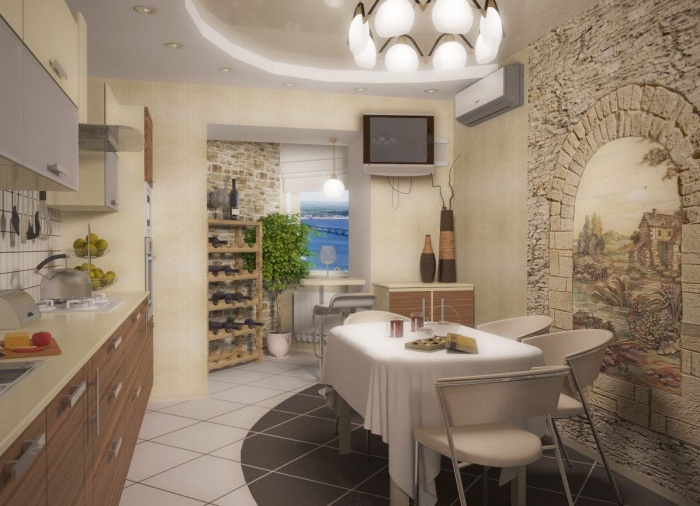
Finishing plaster is of several types:
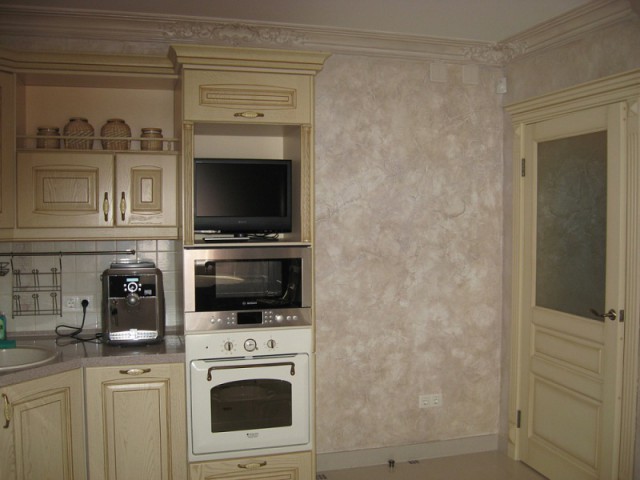
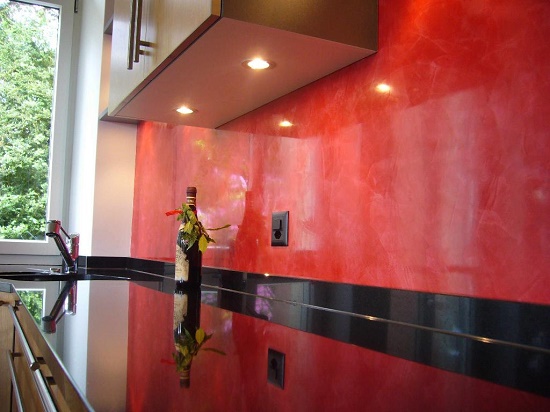
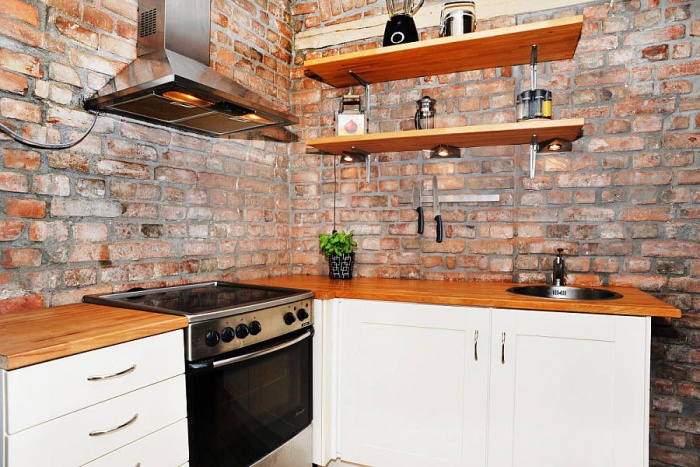
The modern market can provide mineral or synthetic plaster for finishing works. The connecting substance in the first is cement, lime base and gypsum. Synthetic material includes polymeric materials such as styrene, acrylic and others.
Interesting ! You can achieve the effect of picturesque plaster using ordinary putty. This finish option will cost much less, but it will look no less beautiful. To increase the strength and durability of the material, after drying it should be varnished.
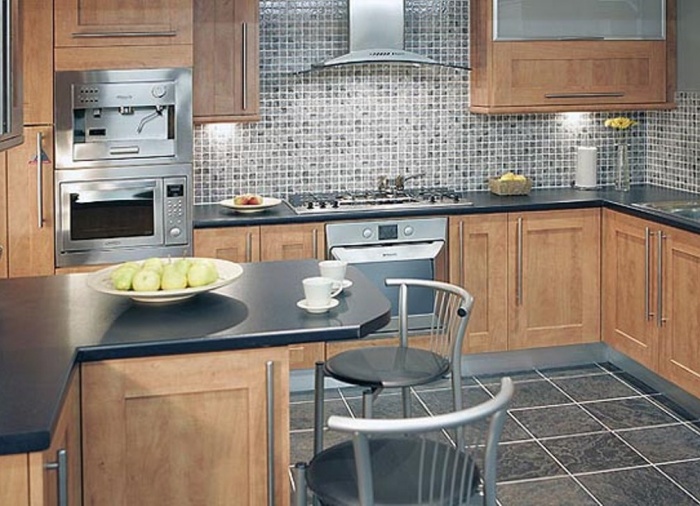
Natural and artificial stone
Application artificial stone in the interior of the kitchen allows you to create original design other than wallpapering or different kind tiles. Of course, a couple of stones are not able to give originality and comfort to the room, but complex installations or stone panels on the walls are quite capable of coping with this task.
There are various cladding options:
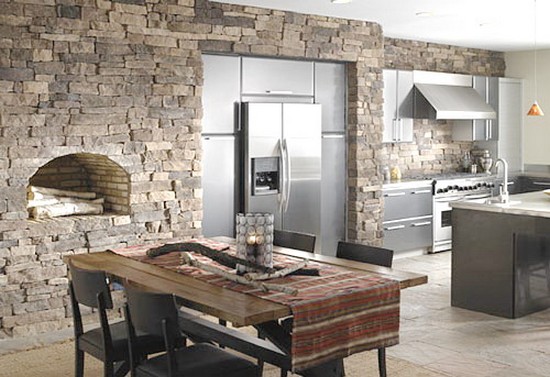
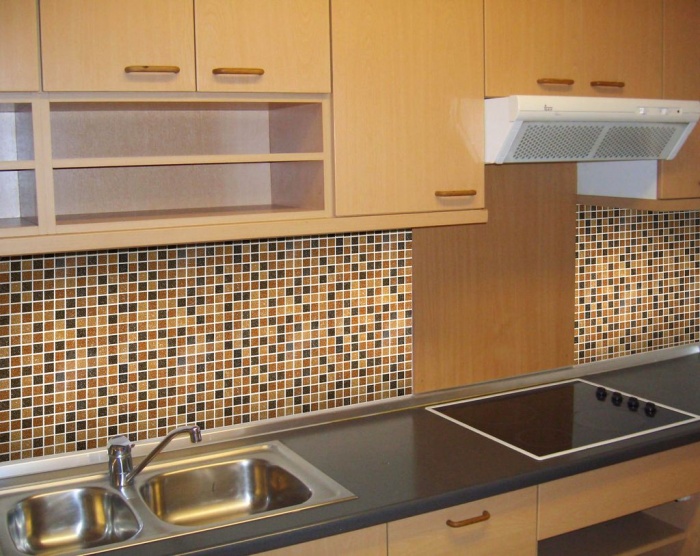
Finishing of artificial stone has undeniable advantages. For example low price and compactness when transporting finishing materials. stone finish Perfectly harmonizes with almost all types of finishing materials. It does not require specialized care and is unpretentious when cleaning. It is enough to wipe it with a damp cloth using a cleaning agent.
![]()
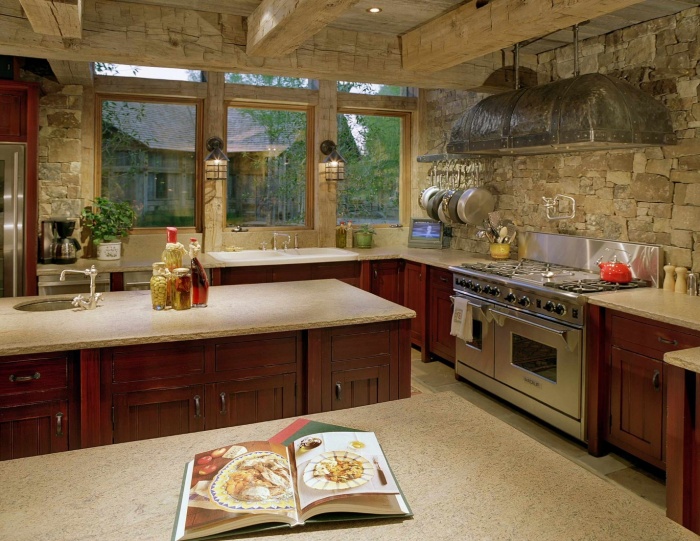
MDF panels
The material that is gaining popularity in recent years is becoming wood board medium density or simply MDF. This is a strong and durable finishing material with a high moisture resistance class and independent of temperature differences. It does not swell at high moisture content and is perfectly protected from the development of various bacteria.
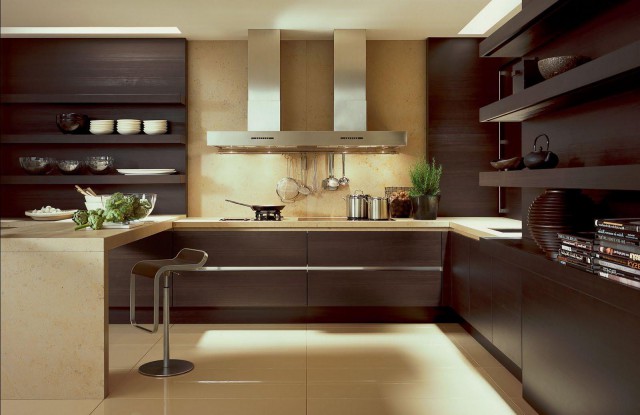
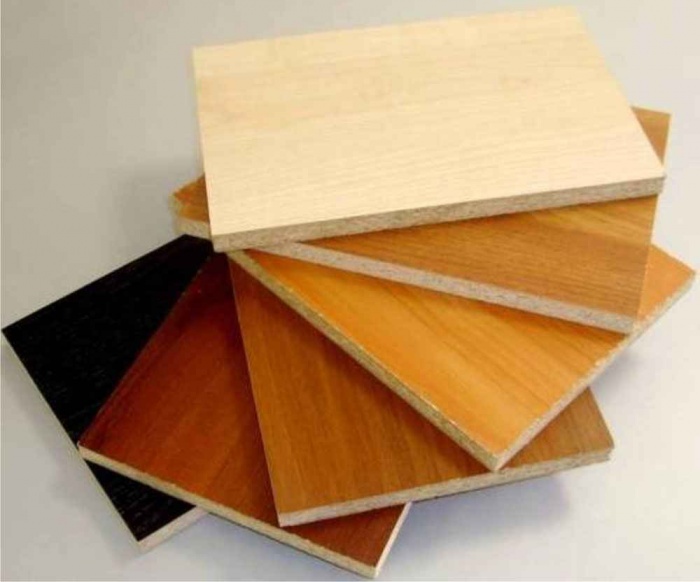
MDF can be of different types:
- Veneered, the installation of which is carried out using veneer.
- Painted panels, the use of which guarantees high resistance to chemical or alkaline attack.
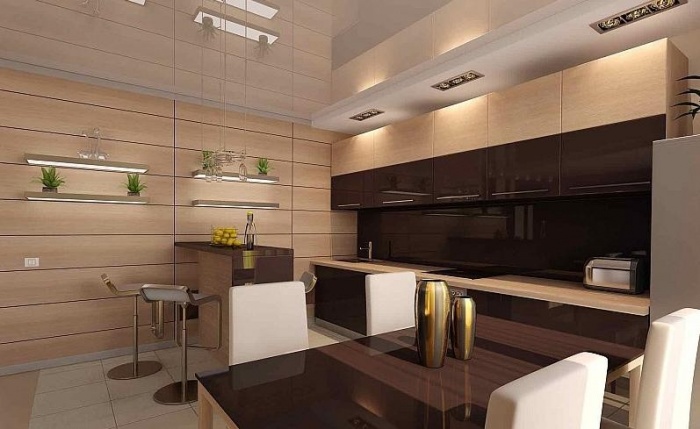
Conclusion
Modern finishing materials are able to satisfy the most unexpected creative requests. Feel free to use new techniques, combine different components, experiment and implement the most daring ideas. Only you can create your own style, go for it and you will certainly succeed.
The kitchen is a kind of room for the realization of design ideas. In this place, a person spends a significant part of his time, and the functional significance that the kitchen has is very high.
In modern houses and apartments, the kitchen is increasingly no longer just a place for cooking. For example, in 1-room studio apartments, the kitchen is part of the living area, but in large houses it is often combined with a dining room or living room.
This range of functionality makes it possible to use almost all modern materials for finishing the kitchen.
Walls can be both decoration and a sign of the squalor of the whole type of kitchen. This is probably why many are trying hard to strain their brains when they begin to think about how to finish the walls of the kitchen.
It is not surprising that the modern building materials market offers them a huge selection of different finishes. But how not to make a mistake in the choice of material?
Materials for finishing the walls of the kitchen can be very different:
- water-based paint
- antimicrobial moisture resistant paint
- wallpaper for walls
- ceramic tile
- Wall panels
- wooden lining
- combined wall decoration
Water based paint
Water-based (or water-dispersed) paint is really a discovery for finishing the kitchen.
This material has many advantages:
- Non-toxic. In the "water emulsion" there are no solvents or other environmentally harmful substances. Such paint does not emit toxic odors.
- Dries quickly. You don't have to worry about the long 24 hour drying process.
All this has nothing to do with water-based paint. While 1 wall in the kitchen is being painted, the previous one will already dry and be ready for re-painting. - Good moisture resistance. This paint is quite resistant to liquid and is able to protect kitchen walls from moisture for a long period of time.
Attention! After covering the walls with paint, the moisture gradually evaporates, leaving behind only a layer of material that hardens and reliably protects the walls from water.
- Doesn't peel off. After all, this is not oil paint, this is a completely new technology for painting with a thin layer.
- Suitable for outdoor work."Water emulsion" passes steam and air, so that the painted walls "breathe", and this is a very important factor.
- Refractory. The components of water-based paint provides this product with resistance to fire.
- Extensive color range. The designer will not have to sit idle, the widest color gamut will help to translate into reality the most unbridled fantasies of a designer with an unhealthy perception of the world.
Simply put, water-based paint is actually a real find for both the owner of the kitchen and the designer who decorates it.
Many builders and renovators are convinced that water-based paint is the most reasonable material for finishing kitchen walls.
Tip: A painted wall is an easy-to-clean surface without any problems. It can be cleaned with a brush or soapy water without worrying about the appearance.
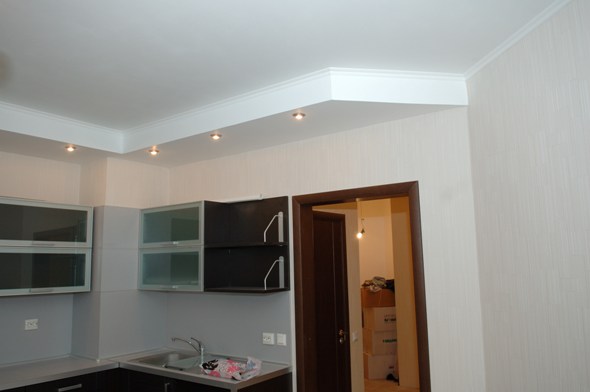
Antimicrobial moisture resistant paint
An excellent option for wall decoration in the kitchen would be antimicrobial moisture-resistant paint. It is surprising that modern humanity creates not only GMOs that are harmful to the human body and other substances of suspicious origin.
A brilliant positive example would be antimicrobial paint.
For reference: In general, it means matte “water emulsion”. Only this is not a standard material, the paint protects the room from the harmful bacteria that surround us everywhere, including in the kitchen.
The material on the wall forms a specific bactericidal film, which forms an environment conducive to the neutralization of harmful microorganisms. Only once on the covered surface, the number of such bacteria decreases by 2 times, and then after 2 hours they are destroyed.
For the kitchen - it's just a discovery. After all, it is here that cooking takes place, which subsequently falls into human body, and, of course, no one will be against reducing the number of harmful bacteria in their body.
The corresponding instructions are sold with the paint, which will tell you how to properly cover the wall.
The advantages of such material:
- Protection against harmful bacteria.
- Odorless and free of toxins.
- Moisture resistant.
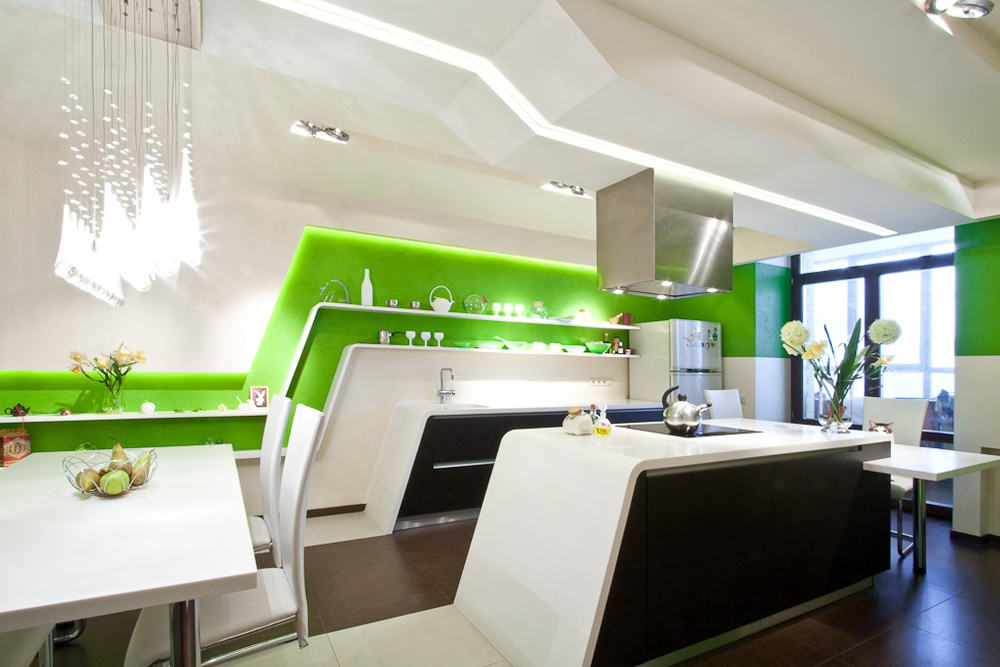
Tip: Remove all release agents such as lime, etc. before applying the antimicrobial moisture resistant paint.
Wallpaper for walls
Wallpaper is one of the most common ways to decorate walls with your own hands. They are common in living rooms, hallways and other residential areas, as well as in kitchens.
But there are certain requirements for kitchen wallpaper. Still, a kitchen is a kitchen - there you will find temperature fluctuations, high humidity, and various fumes - in other words, there is some kind of aggressive environment that adversely affects materials that are not ready for this.
Experts in the field of kitchen renovation recommend using high-quality wallpaper for wall decoration in the kitchen.
And how not to make a mistake in choosing wallpaper for the walls in the kitchen? After all, inaccuracy here can be costly!
Especially if you do not glue wallpaper at home, but, for example, in the kitchen of your parents. It is difficult to even imagine the scale of the results that may appear after the first cleaning of “poor-quality” wallpaper by the mother.
You can choose from the following wallpapers:
- Moisture resistant wallpaper, the very name of the material speaks for itself. They are of several types: printed (made on paints), printed wallpaper with a protective film (in such wallpaper the front side is covered with special polymer emulsions), wallpaper made by embossing (a colored polymer film is applied to the paper), baseless with a printed pattern (there is no base , but there is an ordinary printed pattern).
Such finishing materials can be safely washed with warm water (they will not pick up moisture and will not be erased). - Structural (textured) wallpaper for painting - two-layer wallpaper, produced with deep relief, have a fairly high density. These wallpapers are much thicker than ordinary duplex paper wallpapers.
Most importantly, such wallpapers can be repainted several times, while maintaining their original quality. - Liquid wallpaper is quite a convenient material. But, like any material, it has its advantages and disadvantages.
The advantage is the ability to obtain a continuous seamless surface. But the disadvantage is that these wallpapers quickly absorb moisture. - If you still choose wallpaper, look at the photo of how they look in the kitchen.
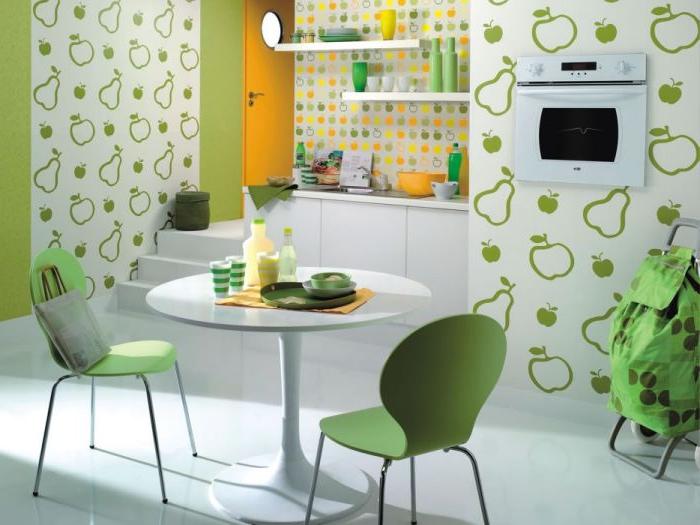
Tip: When choosing wallpaper for the kitchen, be sure to check the product labeling: the “wave” indicator indicates resistance to moisture, and “wave with a brush” indicates resistance to mechanical damage.
Ceramic tile
This material is the most common due to a number of advantages:
- Practicality. If you want to fry food without the fear of splattering the exterior of your kitchen walls, then tile is the best option.
- Wear resistance. You can wipe and wash ceramic tiles at least a hundred times, as it will not lose its original appearance.
- Moisture resistance. Moisture is not the enemy of ceramic tiles. After all, it will not swell, swell or fall off the surface of the wall.
- A wide range of patterns and decors. Thousands of shades and colors will not let you get bored.
Styling features
Everyone knows that it is not at all necessary to have professional skills to decorate a room with tiles. Repairs can be easily done on your own.
You will need the following tools:
- turning cutter or tile cutter,
- building level,
- metal scissors,
- pliers,
- spatulas,
- chisel and hammer.
And, accordingly, materials:
- tile,
- primer,
- glue,
- cross stitches,
- grout,
- metal profile.
Before you get started, it's better to watch the video, especially for beginners.
Tip: In places where the tile will be closed by door frames, it is more economical to lay cut fragments.
Wall panels
Are you still thinking about what material to decorate the kitchen with? Panels for the kitchen - the best solution.
After all, they have so many advantages:
- Ease of installation. Installation of wall panels can be performed even by an inexperienced specialist. Installation should be carried out not only on a completely smooth surface, but also on imperfect walls.
Imperfections in the walls can be masked with PVC grating or a simple wooden beam. - Huge range of decors. Wall panel manufacturers produce the greatest variety of decors, which makes the work of the designer very easy.
- Water repellent properties. Not all wall panels have the ability to repel water.
But the wall panels for the kitchen are certainly resistant to moisture. - Resistant to temperature extremes.
Tip: In the process of working on the kitchen apron area, you need to keep in mind that some part of the material may be defective, another part will have to be spent on cutouts for communications. When calculating, it is better to lay 10% on waste.
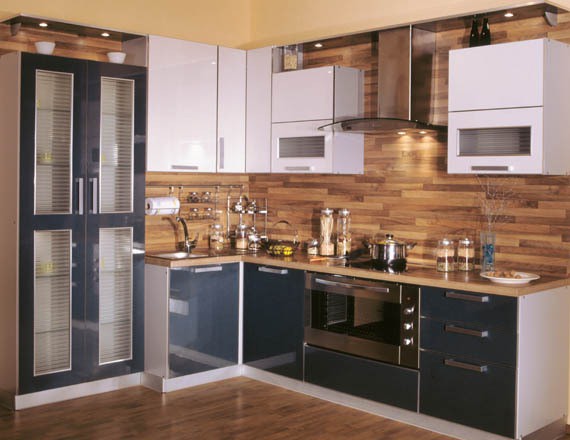
Wooden lining
What else can be better than natural finishing materials? Just imagine a kitchen with wooden clapboard walls.
Indescribable beauty! Here you will find both environmental friendliness and a sense of "life". A tree is a tree.
It should be noted that the process of finishing the walls with clapboard implies a decrease in the perimeter by about 4 cm. The fact is that the mounting rails and the board together make up a thickness of 4 cm.
Thus, it turns out that your kitchen will slightly decrease in width and length by about 8 cm. A trifle, but not entirely pleasant.
Tip: Among the finishing methods, you can choose both full (top to bottom) wall cladding, and partial, by mounting wooden panels to the middle of the wall.
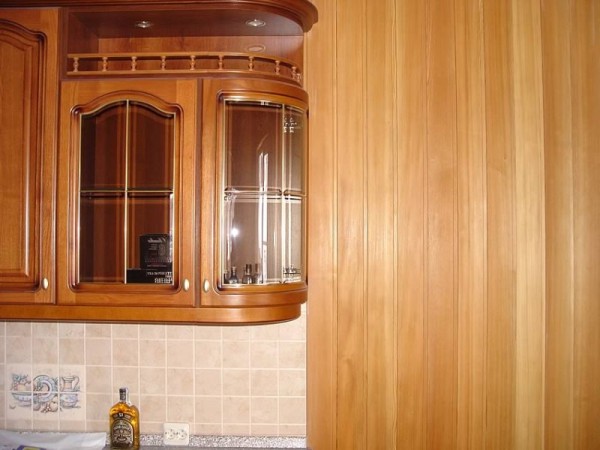
Renovation in the kitchen is a process that everyone faces sooner or later. Suppose the main design idea, the look of the dream kitchen has already taken shape.
The color scheme of the furniture has been determined. The next question arises, what materials for wall decoration in the kitchen to choose?
It is clear that when you go to a building supermarket, you will find racks leading somewhere far away, which are overflowing with cans and jars, rolls of mixtures that can be used for finishing.
How not to get lost at the sight of abundance modern materials and choose the most practical, comfortable, safe, stylish and modern ones? Moreover, the price should be reasonable!




















